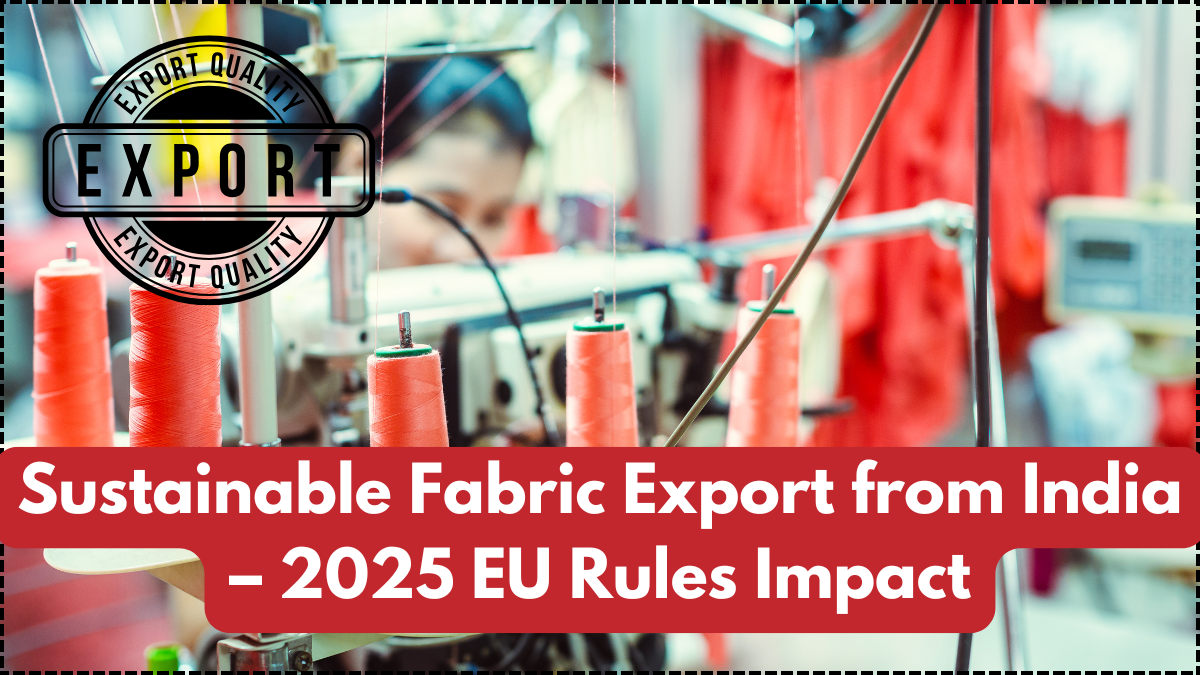The Sustainable Fabric Export sector in India is witnessing a dynamic transformation in 2025, driven largely by stringent environmental regulations from global markets, especially the European Union. With EU compliance becoming mandatory for textile and fabric imports, Indian exporters are now shifting their strategies toward eco-conscious manufacturing. This shift is not just about meeting policy requirements—it’s about staying relevant and competitive in the international market.
The EU has introduced new sustainability benchmarks that aim to reduce carbon footprints and promote transparency in the textile supply chain. For Indian manufacturers, this means a comprehensive reevaluation of their processes, right from raw material sourcing to final packaging. As the world increasingly prioritizes planet-friendly practices, India’s textile industry is adapting fast to maintain its edge in sustainable fabric export.
The good news is that India’s rich heritage of natural fibers like cotton, jute, and silk gives it a unique advantage. When supported by modern, eco-friendly technology and sustainable production methods, these materials are in high demand across Europe.

What’s Driving the Shift Toward EU Compliance?
Compliance with EU regulations is no longer optional for fabric exporters. The EU’s Green Deal and Circular Economy Action Plan have made it essential for manufacturers to prove sustainability at every stage of production. Here’s what’s influencing this rapid pivot:
-
Introduction of the EU’s Corporate Sustainability Due Diligence Directive
-
Mandatory labeling on textile origin, recyclability, and carbon impact
-
Rising demand for traceable, ethically sourced fabrics
-
Penalties for non-compliance and delayed shipment approvals
-
Preference for suppliers with proven environmental responsibility
These factors push Indian manufacturers to revamp their supply chains. As a result, the sustainable fabric export market in India is not just growing—it’s evolving to meet a new international standard.
Types of Sustainable Fabrics Gaining Global Attention
Indian exporters are now offering a wide variety of sustainable fabric options that comply with EU norms. Below is a table of some top-performing eco-friendly fabrics and their features:
| Sustainable Fabric | Key Features | Popular Export Destinations |
|---|---|---|
| Organic Cotton | No chemical fertilizers or pesticides used | Germany, France, Netherlands |
| Hemp | Low water usage, biodegradable | UK, Sweden, Denmark |
| Bamboo Fabric | Naturally antibacterial, highly breathable | Italy, Spain, Belgium |
| Tencel (Lyocell) | Made from wood pulp, biodegradable | Austria, Finland, Poland |
| Recycled Polyester | Made from PET bottles, low environmental impact | France, Norway, Czechia |
These fabrics are not only environmentally sound but also highly marketable due to their comfort, durability, and appeal to eco-conscious consumers.
How Indian Exporters Are Adapting
To meet the high standards of EU compliance, Indian exporters are taking concrete steps across their operations. These include:
-
Setting up GOTS- and OEKO-TEX-certified manufacturing units
-
Investing in zero-liquid discharge (ZLD) dyeing plants
-
Using digital platforms to track and report sustainability metrics
-
Partnering with European buyers for collaborative product development
-
Shifting to low-impact dyes and natural finishes
The goal is not just regulatory compliance but building long-term trust with international buyers. Exporters understand that sustainable fabric export isn’t just a market segment—it’s the future of textile trade.
Government and Industry Support
Recognizing the strategic importance of sustainable fabric export, the Indian government has started incentivizing green manufacturing. Through schemes and collaborations with global sustainability bodies, exporters receive:
-
Financial subsidies for installing eco-tech infrastructure
-
Training on international standards for EU compliance
-
Support in obtaining green certifications
-
Guidance for exporting under free trade agreements with Europe
Organizations like the Cotton Textiles Export Promotion Council (TEXPROCIL) and Apparel Export Promotion Council (AEPC) are also helping exporters stay updated on changing global policies.
Conclusion
India’s focus on sustainable fabric export in 2025 aligns perfectly with global environmental priorities. With EU compliance becoming a gateway to international markets, Indian textile exporters are not only upgrading their systems but redefining industry norms. By blending tradition with innovation and responsibility, India is poised to become a leader in sustainable textile solutions for the global market.
Frequently Asked Questions
What are the EU requirements for fabric exports in 2025?
The EU requires textile exports to comply with sustainability standards related to environmental impact, traceability, recyclability, and ethical sourcing.
Why is EU compliance important for Indian fabric exporters?
It is essential for gaining access to European markets. Non-compliance can result in shipment rejections, penalties, or trade restrictions.
Which fabrics from India are considered sustainable?
Popular sustainable fabrics include organic cotton, hemp, bamboo, recycled polyester, and lyocell (Tencel), all of which meet EU norms.
Is the Indian government supporting exporters in this shift?
Yes, various financial and technical support schemes are being offered to help manufacturers upgrade their operations and obtain necessary certifications.
Click here to learn more